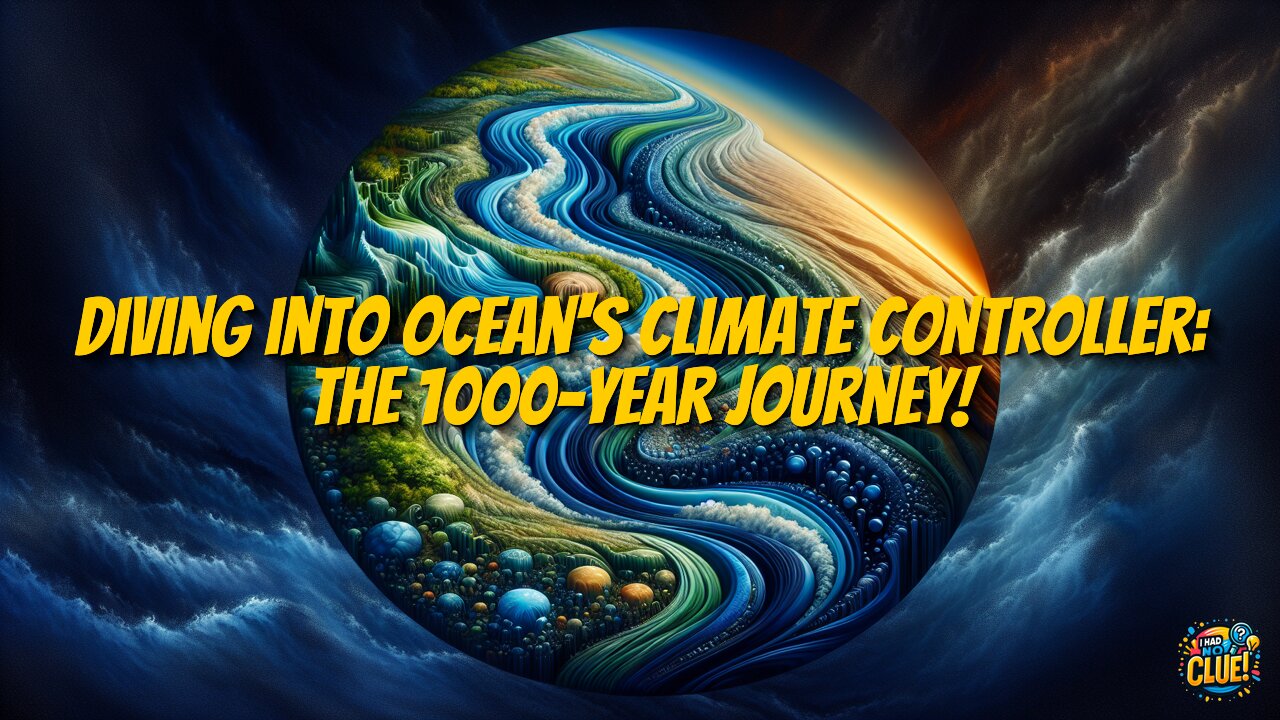Premium Only Content

Diving into Ocean's Climate Controller: The 1000-Year Journey!
https://www.ihadnoclue.com/article/1069004859996733441
Thermohaline circulation refers to a global network of underwater currents that transport heat, nutrients, and dissolved gases throughout the world's oceans. This circulation system, which moves nearly 100 times the volume of the Amazon River, is powered primarily by differences in water density, which vary with temperature and salinity. Oceanographer Wallace Broecker's research in the 1980s revolutionized our understanding of the role these currents play in shaping global climate patterns. The journey of a single water molecule through this "Great Ocean Conveyor Belt" can take approximately 1,000 years.
The process begins primarily in the North Atlantic near Greenland and Iceland, where surface water cools dramatically in winter and increases in density due to expelled salts from forming sea ice. This dense, cold water sinks to great depths and flows southward, forming the North Atlantic Deep Water (NADW). Meanwhile, another dense water formation in the Southern Ocean surrounding Antarctica forms the Antarctic Bottom Water (AABW). These deep currents warm and become less thick as they flow through the ocean basins, rising back to the surface in 'upwelling' zones, primarily in the North Pacific and Indian Oceans. Modern oceanographic instruments have revealed the complexity of this system, showing that thermohaline circulation consists of numerous interconnected pathways with branches, recirculation zones, and eddies.
The thermohaline circulation is crucial in Earth's climate regulation, nutrient redistribution, carbon cycle, and biodiversity. However, anthropogenic climate change, particularly the accelerating melting of the Greenland ice sheet, threatens to disrupt this delicate system, potentially altering global climate patterns and impacting agriculture. Recognizing the importance of thermohaline circulation, scientists have deployed sophisticated monitoring systems across the world's oceans to detect changes in the system and gain crucial information for navigating our future on a changing planet.
-
 21:39
21:39
Nikko Ortiz
2 days agoI Take A North Korean Shooting
4.26K3 -
 1:46:26
1:46:26
The Michelle Moore Show
16 hours ago'The Religion Invasion In the U.S. and the Deep State Agenda' Guest, Mark Taylor: The Michelle Moore Show (Nov 3, 2025)
13.3K21 -
 LIVE
LIVE
TruthStream with Joe and Scott
5 days agoSovereign Codes & Cosmic Infrastructure,Ufo's, UAP's, Monads, Matrix Satellites, Interstellar Visitors, SYRONA #505
177 watching -
 LIVE
LIVE
Lofi Girl
2 years agoSynthwave Radio 🌌 - beats to chill/game to
116 watching -
 5:55:11
5:55:11
MattMorseTV
9 hours ago $83.35 earned🔴Trump's '60 Minutes' INTERVIEW + MUCH MORE.🔴
152K40 -
 2:02:36
2:02:36
Badlands Media
14 hours agoBaseless Conspiracies Ep. 157: Jack the Ripper, the Crash & the Great Disclosure Countdown
31.6K20 -
 2:06:09
2:06:09
Inverted World Live
10 hours agoMysterious Crash at Area 51 | Ep. 134
31K13 -
 2:48:59
2:48:59
TimcastIRL
8 hours agoTrump Endorses Cuomo, Says NO COMMIE MAMDANI, Obama REFUSES To Endorse Mamdani | Timcast IRL
271K185 -
 5:51:16
5:51:16
Drew Hernandez
1 day agoGOP CIVIL WAR: TUCKER CARLSON DERANGEMENT SYNDROME AT ALL TIME HIGH
55.4K41 -
 14:44
14:44
Sponsored By Jesus Podcast
1 day agoYou Can't Serve God & MONEY | Is Money the Root of All Evil?
24.9K23